
FOLKLORE
Scope & Guideline
Diving Deep into the World of Folklore
Introduction
Aims and Scopes
- Exploration of Mythology and Folklore:
The journal places a strong emphasis on the study of myths and folklore, examining their roles in cultural identity, societal norms, and historical narratives across various cultures. - Cultural and Social Analysis:
Papers often delve into the sociocultural implications of folklore, analyzing how traditional narratives shape community values, beliefs, and practices. - Interdisciplinary Approaches:
'FOLKLORE' promotes interdisciplinary research, inviting contributions that integrate perspectives from anthropology, literature, history, and cultural studies, thereby enriching the discourse surrounding folklore. - Focus on Contemporary Issues:
The journal addresses contemporary themes, such as the impact of technology and globalization on traditional folklore, revealing how age-old narratives adapt to modern contexts. - Preservation and Revitalization of Cultural Heritage:
A significant aim is to highlight efforts in preserving and revitalizing endangered folklore and cultural practices, emphasizing their importance in sustaining cultural diversity.
Trending and Emerging
- Folklore and Digital Media:
An increasing number of articles explore the intersection of folklore and digital media, examining how social media and technology influence the dissemination and transformation of traditional narratives. - Environmental and Ecological Folklore:
Research addressing the relationship between folklore and environmental issues is on the rise, highlighting how traditional narratives can inform contemporary ecological understandings and practices. - Gender and Folklore:
There is a significant trend towards analyzing gender roles and representations within folklore, with a focus on how narratives reflect and challenge societal norms regarding gender. - Globalization and Cultural Exchange:
Emerging studies investigate the impacts of globalization on folklore, including the hybridization of narratives and the ways in which cultural exchanges reshape traditional stories. - Health and Folklore:
Recent publications indicate a growing interest in the relationship between folklore and health, particularly in how traditional narratives inform understandings of health practices and beliefs in various cultures.
Declining or Waning
- Traditional Folklore in Isolation:
There appears to be a declining focus on traditional folklore studies that do not engage with contemporary cultural dynamics. Papers solely focused on historical folklore without contextual relevance to modern society are less frequently published. - Narrow Cultural Studies:
Research that concentrates solely on a single cultural or regional folklore without comparative perspectives has become less prevalent, as the journal increasingly emphasizes interdisciplinary and cross-cultural analyses. - Static Methodological Approaches:
There has been a noticeable decrease in papers employing static or outdated methodologies in folklore research. The journal now favors innovative and dynamic research methodologies that reflect current academic standards.
Similar Journals
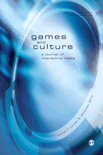
Games and Culture
Illuminating the Impact of Gaming on Cultural DynamicsGames and Culture is a premier interdisciplinary journal published by SAGE Publications Inc, focusing on the rich intersection of gaming, culture, and society. With an ISSN of 1555-4120 and an E-ISSN of 1555-4139, this esteemed journal facilitates critical discussions and innovative research contributions in fields ranging from anthropology and communication to applied psychology and cultural studies. Its exceptional standing is reflected in its various Scopus rankings, placing it in the 99th percentile for Cultural Studies and the 98th percentile for Anthropology, among others. Covering research from its inception in 2006 through 2024, Games and Culture is devoted to advancing the understanding of how games influence cultural expressions and vice versa, making it an invaluable resource for academics, practitioners, and students alike. While the journal is not open access, its comprehensive scope and high-impact findings ensure that it remains a crucial platform for scholarly exchange and discovery in understanding the increasingly significant role of gaming in contemporary culture.
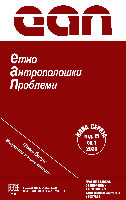
Etnoantropoloski Problemi-Issues in Ethnology and Anthropology
Exploring cultural dynamics through innovative research.Etnoantropoloski Problemi-Issues in Ethnology and Anthropology, published by the University of Belgrade, Faculty of Philosophy, is a prestigious open-access journal dedicated to advancing the fields of ethnology and anthropology. With its ISSN 0353-1589 and E-ISSN 2334-8801, the journal has been a crucial platform since 2006, facilitating the dissemination of innovative research and critical discussions among scholars worldwide. As an open-access journal, it ensures that valuable insights and findings are readily accessible, promoting knowledge sharing and collaboration across the academic community. The journal aims to explore and address contemporary issues in cultural studies, social dynamics, and human behavior, emphasizing the relevance of ethnological and anthropological research in understanding our increasingly interconnected world. Researchers, professionals, and students alike will find Etnoantropoloski Problemi an essential resource for staying informed about the latest developments and debates within these dynamic disciplines.

Heranca-Revista de Historia Patrimonio e Cultura
Advancing Knowledge in History and PreservationHerança - Revista de História, Patrimonio e Cultura is a distinguished academic journal published by Ponteditora in Portugal, dedicated to the exploration and preservation of history, heritage, and culture. Since its inception in 2018, this open-access journal has established a strong foothold in the academic community, becoming a valuable resource for researchers, professionals, and students alike. With an impressive presence in the Scopus rankings—ranking Q3 in multiple categories such as *Arts and Humanities (Miscellaneous)* and *Cultural Studies*—the journal demonstrates its commitment to advancing interdisciplinary dialogue and fostering innovation in the humanities. By offering unrestricted access to its rich array of scholarly articles, Herança plays a vital role in disseminating knowledge and promoting further research in the fields of history, museology, and the arts. With an aim to bridge theoretical insights and practical applications, this journal stands as an essential contributor to the cultural landscape and heritage studies, making it a pivotal platform for contemporary issues in our understanding of cultural identity and heritage conservation.
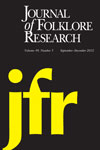
JOURNAL OF FOLKLORE RESEARCH
Fostering Dialogue in Folklore ScholarshipJOURNAL OF FOLKLORE RESEARCH, published by Indiana University Press, serves as a vital platform for scholarly exploration within the realms of folklore, cultural studies, and music. With an ISSN of 0737-7037 and an E-ISSN of 1543-0413, this journal has converged its content from 2002 to 2024, facilitating a dynamic discourse on the interplay of traditional narratives and contemporary cultural forms. Despite its current tier in the Q4 category for both Cultural Studies and Music, the journal is increasingly recognized for its contributions, ranking 69th in Music and 526th in Cultural Studies as per the latest Scopus metrics. Researchers, professionals, and students alike will find this journal an essential resource, rich with insights that traverse the complexities of human expression and societal narratives. Although not an open-access journal, the valuable research contained within its pages is crucial for advancing knowledge in folklore scholarship and its related disciplines.

Architecture and Culture
Advancing Interdisciplinary Insights in Built EnvironmentsArchitecture and Culture is an esteemed journal published by Routledge Journals, Taylor & Francis Ltd, focusing on the intersection of architecture, cultural studies, urbanism, and the visual and performing arts. Since its inception, this journal has become a vital platform for researchers, professionals, and students to explore the multifaceted relationship between architecture and cultural identity within contemporary contexts. With an ISSN of 2050-7828 and an E-ISSN of 2050-7836, the journal reaches a global audience from its base in the United Kingdom. Featuring a commendable Q2 ranking in Visual Arts and Performing Arts and a consistent presence in multiple relevant quartiles, including Q3 in both Architecture and Cultural Studies, it is well-regarded for its scholarly impact. The journal offers a unique opportunity for interdisciplinary dialogue, fostering innovative research that examines how built environments shape and are shaped by cultural narratives. This commitment to advancing knowledge in these fields is reflected in its ongoing publication from 2014 to 2024, making it a pivotal resource for those at the forefront of the discourse on architecture and culture.
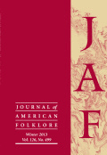
JOURNAL OF AMERICAN FOLKLORE
Exploring the Heartbeat of American CultureJOURNAL OF AMERICAN FOLKLORE, published by the American Folklore Society, is a distinguished journal dedicated to the exploration and analysis of folklore, cultural traditions, and the diverse narratives that shape American identity. With a rich history dating back to its inception, the journal has positioned itself as a leading platform in the field, boasting a 2023 ranking of Q1 in Cultural Studies and Q2 in Arts and Humanities (miscellaneous). The journal's impact within the academic community is underscored by its high Scopus rankings, placing it in the 83rd and 65th percentiles in Cultural Studies and Arts and Humanities, respectively. Readers can access a wealth of insightful articles that contribute to ongoing discussions in folklore studies, cultural anthropology, and related disciplines. As the study of folklore becomes increasingly relevant in understanding contemporary societal dynamics, JOURNAL OF AMERICAN FOLKLORE serves as an essential resource for researchers, professionals, and students alike, enriching discourse and fostering a deeper appreciation for the cultural experiences that define America.

Amaltea-Revista de MitocrItica
Bridging Literature and Culture for Global InsightsAmaltea-Revista de Mitocrítica is a reputable academic journal published by UNIV COMPLUTENSE MADRID, SERVICIO PUBLICACIONES, focusing on the fields of Cultural Studies and Literature and Literary Theory. Since its inception in 2008, this Open Access journal has been committed to fostering scholarly dialogue and enhancing accessibility to cutting-edge research within these dynamic fields. Based in Madrid, Spain, Amaltea provides an essential platform for researchers, professionals, and students interested in exploring the interplay between literature and culture, allowing them to disseminate their findings to a global audience. With a commendable positioning in the Q3 quartile across both related fields, as well as competitive rankings within Scopus, Amaltea stands as a significant contributor to contemporary academic discourse. Its dedication to high standards of publication ensures that emerging ideas as well as established scholarship are adequately represented and critically examined, making it a vital resource for those invested in the nuances of cultural and literary critiques.

OSTERREICHISCHE ZEITSCHRIFT FUR VOLKSKUNDE
Navigating the Landscape of Folklore StudiesOSTERREICHISCHE ZEITSCHRIFT FUR VOLKSKUNDE is a dedicated academic journal published by the VEREIN FUR VOLKSKUNDE that focuses on the interdisciplinary study of folklore and ethnology, particularly in the Austrian context. With a long-standing history of contributing to cultural studies, this journal serves as an essential resource for researchers, professionals, and students interested in the nuances of social practices, traditions, and cultural narratives. Although it has ceased its indexing in Scopus as of 2019, its impact is reflected in its rankings, particularly in the categories of Social Sciences and Arts and Humanities, making it a crucial reference point for those studying cultural phenomena. The journal, with ISSN 0029-9669, is based in Vienna, Austria, and offers a rich compendium of articles that promote scholarly discourse and broaden understanding in the field of Volkskunde. As it continues to foster academic dialogue, OSTERREICHISCHE ZEITSCHRIFT FUR VOLKSKUNDE remains a notable contributor to the evolution of cultural studies in the region and beyond.
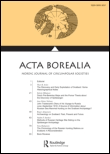
Acta Borealia
Connecting Cultures Through Rigorous ResearchActa Borealia is a prestigious academic journal published by ROUTLEDGE JOURNALS, TAYLOR & FRANCIS LTD, based in the United Kingdom. Since its inception in 1984, the journal has established itself as a vital platform for scholarly discourse in the fields of Anthropology, Cultural Studies, History, Sociology, and Political Science. With a commendable impact factor and placement in Q1 and Q2 quartiles across various categories, it demonstrates a strong commitment to high-quality research and innovative contributions. The journal is well-ranked in Scopus metrics, highlighting its influence and reach within the arts and humanities as well as social sciences. Acta Borealia publishes original research articles, reviews, and critical essays, making it an essential resource for researchers, professionals, and students alike seeking to enhance their understanding of northern studies and related fields. While securing access may require institutional login or subscription, the journal's rich content continues to foster interdisciplinary discussions that are critical for navigating complex social issues.

FABULA
Innovating Cultural Critique and Literary TheoryFABULA is a distinguished academic journal published by WALTER DE GRUYTER GMBH, focused on the fields of Cultural Studies and Literature and Literary Theory. Since its inception in 1958, FABULA has contributed significantly to the discourse surrounding narrative theory, literary analysis, and cultural criticism, positioning itself as a vital platform for innovative research. With a Q2 ranking in Literature and Literary Theory and a Q3 ranking in Cultural Studies for 2023, the journal demonstrates its commitment to high-quality scholarship while fostering interdisciplinary dialogue among researchers and professionals. Although it currently does not offer Open Access options, its rigorous selection process ensures that published works meet the highest academic standards. Located in Berlin, Germany, FABULA remains a crucial resource for scholars seeking to deepen their understanding of the complexities inherent in narrative forms and their cultural implications, supporting ongoing research endeavors from 1964 through 2024.